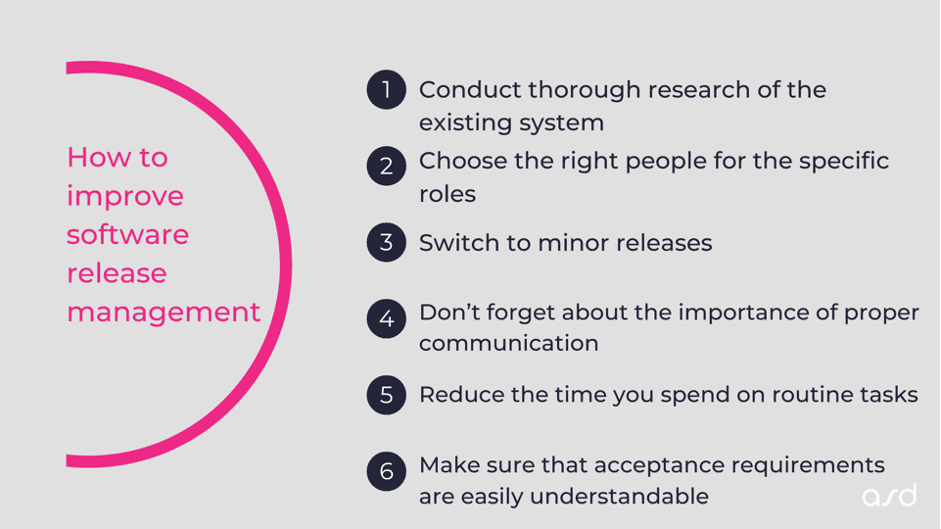6 Tips On Improving Software Release Management Process
5 minutes read
Is software release management a fundamental process to conduct?
Software release management is a long-time process as it starts from the very beginning and finishes after its primary goal is to deploy the developed software.
The purpose of software release management is to release software accurately and to do that, all the active roles in the process have to put in a lot of effort, hard work, and specialism.
Proper software release management ensures a successful software deployment and covers the following processes:
The process usually represents itself by a checklist, including the following points and steps:
Software release management usually consists of 4 steps:
Step 1. Define the requirements and criteria of the release.
First of all, you need to define what you are developing and what it should look like. Due to that fact, you have to develop strict and clear requirements and criteria to check if the development process goes in the right direction.
Step 2. Define acceptance criteria for the requirements.
During this step, it is necessary to define what exactly the development team has to do and what result satisfies the needs. Acceptance criteria can look like a checklist. For example, imagine that you are developing a mobile application, and you state the following:
Step 3. Put deployments to the staging environments.
Putting deployment to the staging environment helps implement changes without changing the existing version used by users right at the moment. The staging environment must be as close as possible to the existing version to exclude possible bugs or issues during the production process.
Step 4. Review by the QA team
QA Team reviews the staging environment to check if all the acceptance criteria are met as needed.
Step 5. Deploy software to production.
After the QA team reviews and approves, it is time to send it to production and deploy it for users.

The first and most obvious thing you can do is review the existing system to reveal all the possible flaws, bugs, or loopholes that affect the system negatively. It is essential to conduct such research to get an accurate picture of the aspects that you need to improve or fix.
Moreover, to make it properly, all the stakeholders should take part in this step to ensure that stakeholders are well informed about aspects of the system that have issues and require fixing.
The quality of the software release management process depends on the professionalism of the team members and how they perform their work in practice.
It is much easier and more profitable to invest time and budget to find and hire specialists who can perform the job properly than to save time and money to hire someone faster to start working.
The second option will lead you to waste more time and resources to fix issues caused by an unprofessional person in the position.
Regular minor releases are better than rare and big releases, and now we will explain why.
Small and regular releases allow us to see and fix possible issues or bugs and discuss which improvements, changes, or potential needs of the product there are.
Set up regular releases according to your team resources to ensure that all the deliverables are high quality, as the main goal is quality, not the quantity of the releases.
Like elsewhere, communication is vital, especially in software release management, unless you and your team members can read thoughts.
Proper communication means it is flawless, continuous, and regular among team members and must be understandable and clear for everyone to discuss any necessary questions.
As a result of high-quality communication, you are getting:
There will always be small daily and routine tasks that take a little time from your team, but in fact, it takes a lot more when you reduce these tasks from the manual. Automating such tasks is a great way to add more time to necessary tasks without broadening the software development budget.
But remember that automatization shouldn’t affect the quality of the process. That’s why before automatizing the process, develop and approve quality standards that will be followed.
Correctly implemented automatization, standardization, and proper maintenance will allow you to focus on more important things.
Requirements are things someone can only describe and write in a way that leaves space for doubting or misunderstandings. Ensure all the requirements are clear and easily understandable so anyone can use them and the key release metrics can be checked.

Each software release management process is unique and requires a specific checklist according to the particular release.
Please read our checklist, where we have gathered a basic pack of steps you need to conduct. You can use this checklist and add the points you need for the software release management process.
Check if stakeholders:
The software development team should :
QA Team should:
DevOps should:
Support team must:
Release management is a necessary process that directly impacts the quality of your product. Following our tips on improving software release management will help you make your process faster, cheaper, and much more productive than it was before.
Our team will contact you within 1 business day. Make sure to check your Spam and Promotions folder just in case.
We use cookies to personalize our services and improve your experience on this website. We may use certain personal data for analytics and marketing purposes.